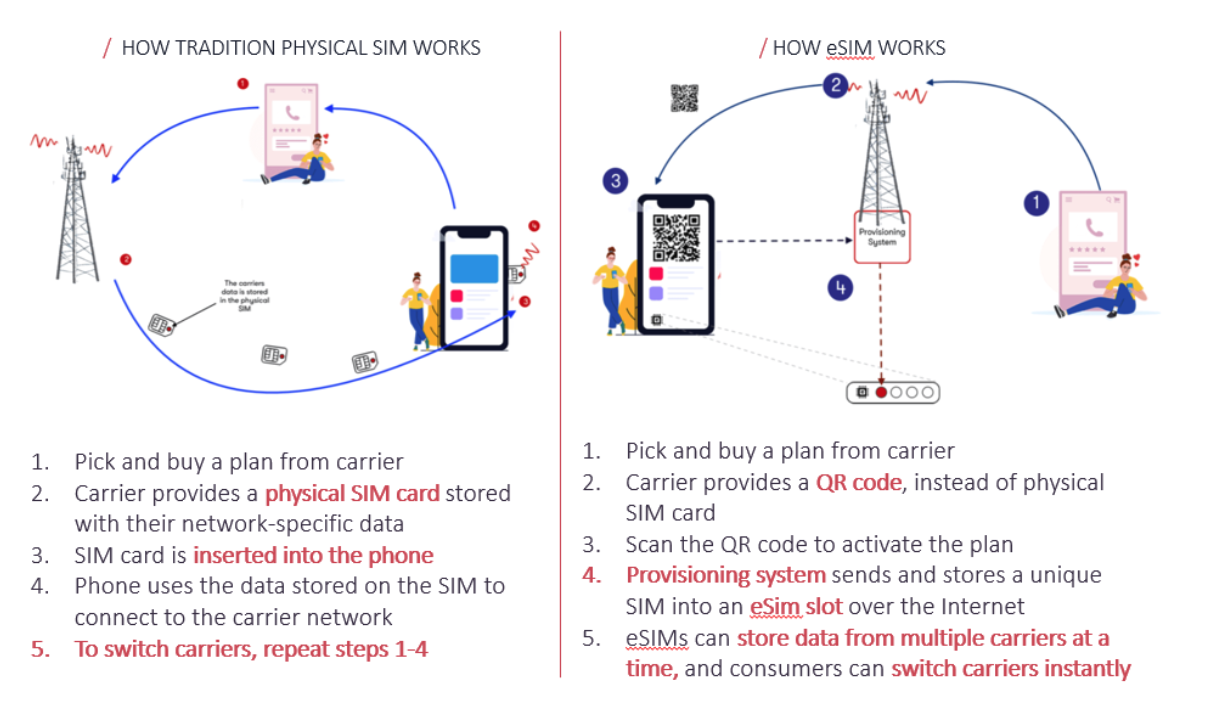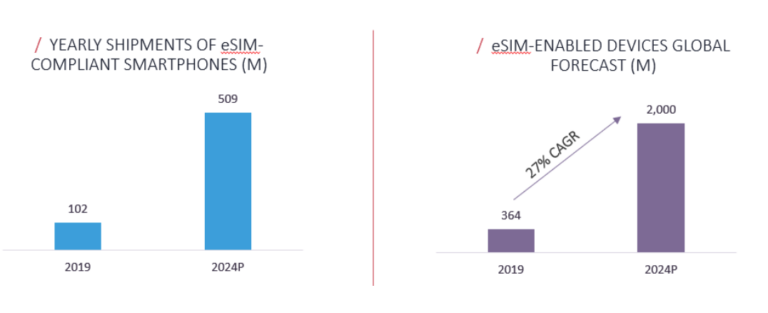No One Is Talking About The Real Revolution in Mobile Wireless (And No, It’s Not 5G)
If you watch any type of live television these days, you are almost guaranteed to see an advertisement for mobile wireless service from AT&T, Verizon, T-Mobile, or one of their sub-brands.
And, if you pay any attention at all to that advertisement, you will probably come away thinking that the cellular industry is about to be absolutely turned on its head by one thing: 5G.
In our opinion, you’d be wrong. Sure, the big telecom players love to tout their multi-billion-dollar investments in 5G infrastructure. Why? Because the consumer value proposition is simple: faster, more powerful wireless connectivity on your mobile device.
But we don’t think this is what will restructure the mobile wireless industry over the next few years. What will? Something that no one seems to be talking about: eSIM technology.
What Is eSIM Technology?
If you’ve owned a cell phone over the past few decades, it almost certainly contained a physical SIM card, inserted into the phone via a SIM slot. This SIM card is effectively a portable memory chip, which stores the data needed to access a specific carrier network – for instance, AT&T’s network of cell towers.
Your SIM card is what made you a subscriber to a particular mobile carrier. Without it, you would not receive cellular service, nor could you use that same SIM card to access a different network (for example, move from AT&T to Verizon service).
If you ever switched carriers or traveled abroad without changing your mobile device, you may have gone through the experience of removing your pre-existing SIM card with an ejector tool and replacing it with a different SIM card.
Embedded SIM, or “eSIM,” technology is essentially a virtual SIM card with empty data slots that comes pre-installed into a mobile device, rather than being manually inserted by the device owner.
After purchasing (or trialing) a plan from a carrier, the carrier will provide a QR code, which can be scanned in order to activate the plan. A provisioning system will then send and store a unique SIM into one of the multiple eSIM slots available on the device over the Internet, at which point the consumer will be ready to connect to that carrier’s network.
Notably, eSIM technology allows a consumer to sign up with any given carrier without needing to procure a physical SIM card, to store the necessary data to access the networks of multiple carriers on their device at the same time, and to switch between those carriers instantly.

What Will eSIM Mean for the Industry?
We believe that the disruptive nature of eSIM technology cannot be overstated.
First and foremost, eSIM almost completely eliminates the massive friction currently associated with switching mobile carriers, which includes needing to procure a physical SIM card by either heading to a retail store or waiting for e-commerce delivery, then fully transitioning from old to new carrier by manually switching SIM cards.
With eSIM, consumers don’t ever need to fully “switch,” if they so choose – eSIM allows a single device to store multiple carrier plans, and even for a single device to have multiple associated phone numbers.
This means that eSIM could enable a consumer to have separate work and personal numbers – with different associated plans – on a single device, to store country-specific carrier plans when traveling internationally, or to switch between domestic carriers to use the most optimal plan in specific scenarios (for example, in rural areas where one network may have stronger coverage).
Additionally, because eSIM means that a device can become Internet-enable without needing to accommodate a physical SIM card slot, a new host of objects could soon become “smart” and connected.
Is It Here Yet?
Yes and no. While the last few generations of most major phone styles, including the Apple iPhone, Samsung Galaxy, and Google Pixel, have supported eSIM from a hardware perspective, the phone carriers themselves have been slower to roll out eSIM plans.
By 2024, it is projected that over 500 million eSIM-enabled devices will be shipped annually, with a cumulative install base of two billion devices.

Why Is No One Talking About It?
Unlike 5G, which incumbent carriers can position as their competitive advantage having made the capital intensive, technically challenging investments in building out their networks, eSIM benefits challenger carrier brands.
By reducing switching friction, eSIM enables a consumer to easily try a lesser-known carrier, with very limited commitment and downside risk.
A consumer could receive an email, or see an ad on the subway, scan the associated QR code and instantly trial a new carrier to compare price and service speeds to their current plan.
Moreover, challenger brands could begin offering things like a 2-week free trial to introduce their plans. This type of promotion would have been much more challenging to execute in the days of physical SIM.
We believe the major players in telecom are not talking about eSIM because it is poised to disrupt their businesses, while creating opportunities for a new vanguard of consumer-centric disruptors to build category-leading brands.
Fortunately for consumers, the eSIM revolution is already here – and chances are, your phone is already equipped with the technology necessary to start experimenting.
